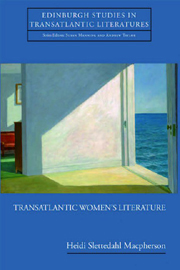Book contents
- Frontmatter
- Contents
- Acknowledgements
- Introduction: ‘No Region for Tourists and Women’
- Part 1: The Exoticised Other
- Introduction
- 1 Constructing Race across the Atlantic: Nella Larsen's Quicksand
- 2 Assimilation in the (Fictional) Heartland: Bharati Mukherjee's Jasmine
- Part 2: Memoirs and Transatlantic Travel
- Part 3: Negotiating the Foreign/Re-Inventing Home
- Conclusion
- Bibliography
- Index
1 - Constructing Race across the Atlantic: Nella Larsen's Quicksand
from Part 1: The Exoticised Other
Published online by Cambridge University Press: 12 September 2012
- Frontmatter
- Contents
- Acknowledgements
- Introduction: ‘No Region for Tourists and Women’
- Part 1: The Exoticised Other
- Introduction
- 1 Constructing Race across the Atlantic: Nella Larsen's Quicksand
- 2 Assimilation in the (Fictional) Heartland: Bharati Mukherjee's Jasmine
- Part 2: Memoirs and Transatlantic Travel
- Part 3: Negotiating the Foreign/Re-Inventing Home
- Conclusion
- Bibliography
- Index
Summary
Nella Larsen's Quicksand (1928) is an early twentieth-century novella that offers a contested reading of racial otherness and transatlantic exoticism. Although it is a flawed text which relies on a series of coincidental encounters and more than a touch of melodrama, it is nevertheless a significant one in relation to questions of transnationalism and identity. Published originally on its own, it is now available only in a volume with a second novella, Passing. Passing receives substantially more critical interest than Quicksand, perhaps because of its subject matter, which, through its title, overtly signals its interest in issues of occluded identity, or perhaps because Quicksand's conclusion points so resolutely to the negative, an ironic closure to a text that explores the problematics of racial uplift.
Quicksand's narrative encourages a bleeding between spaces and identities as it limns the peripatetic life of Helga Crane. Helga believes that she was born out of wedlock, and this early uncertainty over identity markers is repeated in a variety of ways throughout the plot. Helga's white Danish mother raised her in the US, after her black American father abandoned the family. Her mother marries a white man when Helga is a child and bears more children, the result of which is Helga's exclusion from family life. She is temporarily ‘rescued’ by a white uncle who sends her to school, and she eventually secures a job teaching in the prestigious, but to her stifling black school, Naxos, which is dedicated to racial uplift.
- Type
- Chapter
- Information
- Transatlantic Women's Literature , pp. 42 - 59Publisher: Edinburgh University PressPrint publication year: 2008



